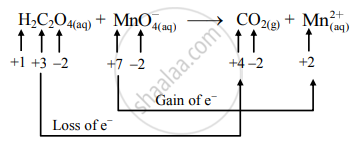Advertisements
Advertisements
Question
Balance the following redox equation by half-reaction method.
\[\ce{H2C2O_{4(aq)} + MnO^-_{4(aq)}->CO2_{(g)} + Mn^2+_{( aq)}(acidic)}\]
Solution
\[\ce{H2C2O_{4(aq)} + MnO^-_{4(aq)}->CO2_{(g)} + Mn^2+_{( aq)}}\]
Step 1: Write the unbalanced equation for the redox reaction. Assign the oxidation number to all the atoms in reactants and products. Divide the equation into two half equations.

- Oxidation half-reaction: \[\ce{H2C2O_{4(aq)}->CO2_{(g)}}\]
- Reduction half-reaction: \[\ce{MnO^-_{4(aq)}->Mn^2+_{( aq)}}\]
Step 2: Balance the atoms except O and H in each half equation. Balance half equation for O atoms by adding 4H2O to the right side of the reduction half equation.
- Oxidation: \[\ce{H2C2O_{4(aq)}->2CO2_{(g)}}\]
- Reduction: \[\ce{MnO^-_{4(aq)}->Mn^2+_{( aq)} + 4H2O_{(l)}}\]
Step 3: Balance H atoms by adding H+ ions to the side with less H. Hence, add 2H+ ions to the right side of the oxidation half equation and 8H+ ions to the left side of the reduction half equation.
- Oxidation: \[\ce{H2C2O_{4(aq)}->2CO2_{(g)} + 2H^+_{( aq)}}\]
- Reduction: \[\ce{MnO^-_{4(aq)} + 8H^+_{( aq)}->Mn^2+_{( aq)} + 4H2O_{(l)}}\]
Step 4: Now add 2 electrons to the right side of the oxidation half equation and 5 electrons to the left side of the reduction half equation to balance the charges.
- Oxidation: \[\ce{H2C2O_{4(aq)}->2CO2_{(g)} + 2H^+_{( aq)} + 2e^-}\]
- Reduction: \[\ce{MnO^-_{4(aq)} + 8H^+_{( aq)} + 5e^-->Mn^2+_{( aq)} + 4H2O_{(l)}}\]
Step 5: Multiply oxidation half equation by 5 and reduction half equation by 2 to equalize the number of electrons in two half equations. Then add two half equations.
- Oxidation: \[\ce{5H2C2O_{4(aq)}->10CO2_{(g)} + 10H^+_{( aq)} + 10e^-}\]
- Reduction: \[\ce{2MnO^-_{4(aq)} + 16H^+_{( aq)} + 10e^-->2Mn^2+_{( aq)} + 8H2O_{(l)}}\]
Add two half equations:
\[\ce{5H2C2O_{4(aq)} + 2MnO^-_{4(aq)} + 6H^+_{( aq)}->10CO2 + 2Mn^2+_{( aq)} + 8H2O_{(l)}}\]
The equation is balanced in terms of the number of atoms and the charges.
Hence, balanced equation: \[\ce{5H2C2O_{4(aq)} + 2MnO^-_{4(aq)} + 6H^+_{( aq)}->10CO2 + 2Mn^2+_{( aq)} + 8H2O_{(l)}}\]
APPEARS IN
RELATED QUESTIONS
Calculate the oxidation number of sulphur, chromium and nitrogen in H2SO5, `"Cr"_2"O"_7^(2-)` and `"NO"_3^-`. Suggest structure of these compounds. Count for the fallacy.
Consider the reaction:
\[\ce{O3(g) + H2O2(l) → H2O(l) + 2O2(g)}\]
Why it is more appropriate to write these reaction as:
\[\ce{O3(g) + H2O2 (l) → H2O(l) + O2(g) + O2(g)}\]
Also, suggest a technique to investigate the path of the redox reactions.
The compound AgF2 is an unstable compound. However, if formed, the compound acts as a very strong oxidizing agent. Why?
Whenever a reaction between an oxidising agent and a reducing agent is carried out, a compound of lower oxidation state is formed if the reducing agent is in excess and a compound of higher oxidation state is formed if the oxidising agent is in excess. Justify this statement giving three illustrations.
How do you count for the following observations?
Though alkaline potassium permanganate and acidic potassium permanganate both are used as oxidants, yet in the manufacture of benzoic acid from toluene we use alcoholic potassium permanganate as an oxidant. Why? Write a balanced redox equation for the reaction.
Balance the following equation in basic medium by ion-electron method and oxidation number methods and identify the oxidising agent and the reducing agent.
\[\ce{P4(s) + OH–(aq) —> PH3(g) + HPO^–_2(aq)}\]
The Mn3+ ion is unstable in solution and undergoes disproportionation to give Mn2+, MnO2, and H+ ion. Write a balanced ionic equation for the reaction.
Choose the correct option.
For the following redox reactions, find the correct statement.
\[\ce{Sn^{2⊕} + 2Fe^{3⊕}->Sn^{4⊕} + 2Fe^{2⊕}}\]
Balance the following reaction by oxidation number method.
\[\ce{MnO^-_{4(aq)} + Br^-_{ (aq)}->MnO2_{ (s)} + BrO^-_{3(aq)}(basic)}\]
Balance the following reaction by oxidation number method.
\[\ce{H2SO4_{(aq)} + C_{(s)}->CO2_{(g)} + SO2_{(g)} + H2O_{(l)}(acidic)}\]
Balance the following reaction by oxidation number method.
\[\ce{Bi(OH)_{3(s)} + Sn(OH)^-_{3(aq)}->Bi_{(s)} + Sn(OH)^2-_{6(aq)}(basic)}\]
Identify coefficients 'x' and 'y' for the following reaction.
\[\ce{{x}H2O2_{(aq)} + ClO^-_{4(aq)} -> 2O2_{(g)} + ClO^-_{2(aq)} + {y}H2O_{(l)}}\]
Which of the following is a redox reaction?
What is the change in oxidation number of Sulphur in following reaction?
\[\ce{MnO^-_{4(aq)} + SO^{2-}_{3(aq)} -> MnO^{2-}_{4(aq)} + SO^{2-}_{4(aq)}}\]
Consider the reaction:
\[\ce{6 CO2(g) + 6H2O(l) → C6 H12O6(aq) + 6O2(g)}\]
Why it is more appropriate to write these reaction as:
\[\ce{6CO2(g) + 12H2O(l) → C6 H12O6(aq) + 6H2O(l) + 6O2(g)}\]
Also, suggest a technique to investigate the path of the redox reactions.
Write balanced chemical equation for the following reactions:
Reaction of liquid hydrazine \[\ce{(N2H4)}\] with chlorate ion \[\ce{(ClO^{-}3)}\] in basic medium produces nitric oxide gas and chloride ion in gaseous state.
Write balanced chemical equation for the following reactions:
Dichlorine heptaoxide \[\ce{(Cl2O7)}\] in gaseous state combines with an aqueous solution of hydrogen peroxide in acidic medium to give chlorite ion \[\ce{(ClO^{-}2)}\] and oxygen gas. (Balance by ion-electron method)
Balance the following equations by the oxidation number method.
\[\ce{Fe^{2+} + H^{+} + Cr2O^{2-}7 -> Cr^{3+} + Fe^{3+} + H2O}\]
Balance the following equations by the oxidation number method.
\[\ce{I2 + NO^{-}3 -> NO2 + IO^{-}3}\]
Identify the redox reactions out of the following reactions and identify the oxidising and reducing agents in them.
\[\ce{3HCl (aq) + HNO3 (aq) -> Cl2 (g) + NOCl (g) + 2H2O (l)}\]
Balance the following ionic equations.
\[\ce{Cr2O^{2-}7 + H^{+} + I- -> Cr^{3+} + I2 + H2O}\]
Balance the following ionic equations.
\[\ce{Cr2O^{2-}7 + Fe^{2+} + H+ -> Cr^{3+} + Fe^{3+} + H2O}\]
In \[\ce{Cu^{2+} + Ag -> Cu + Ag^+}\], oxidation half-reaction is:
